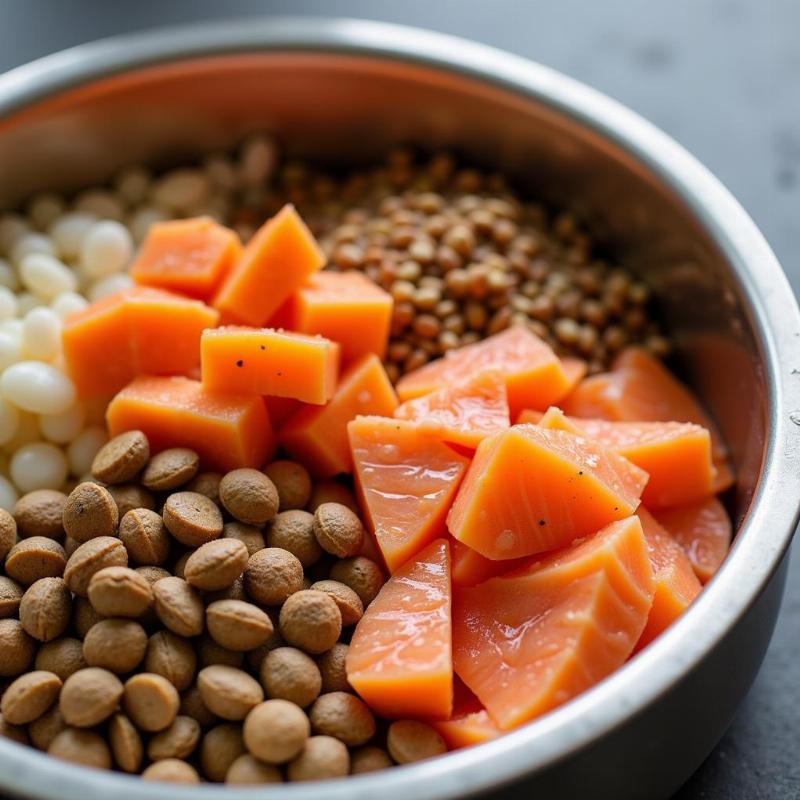Grain and poultry free dog food has become increasingly popular in the US, driven by concerns about allergies, sensitivities, and the desire for a more “natural” diet. But is this dietary trend truly beneficial for all dogs? This guide will delve into the world of grain and poultry free dog food, exploring its potential benefits, drawbacks, and what you should consider before making the switch for your canine companion.
Understanding the Need for Grain and Poultry Free Dog Food
Many dog owners opt for grain and poultry free dog food due to suspected food allergies or intolerances. Common symptoms include itchy skin, digestive upset, and ear infections. Chicken, a common ingredient in many dog foods, is a frequent allergen, along with grains like wheat and corn. While less common, some dogs may also be allergic to turkey, duck, or other poultry sources. Eliminating these ingredients can significantly improve a dog’s quality of life if they are indeed the source of the problem. However, it’s crucial to consult with a veterinarian before making any dietary changes, as these symptoms can also be indicative of other health issues.
 Grain and Poultry Free Dog Food Ingredients
Grain and Poultry Free Dog Food Ingredients
Navigating the World of Grain and Poultry Free Options
Choosing the right grain and poultry free dog food can be daunting. The market is flooded with options, each boasting unique benefits. Look for foods that prioritize high-quality protein sources like fish (salmon, whitefish), beef, lamb, or novel proteins like kangaroo or venison. Ensure the food is complete and balanced, meaning it meets the Association of American Feed Control Officials (AAFCO) nutritional standards for dogs. Reading the ingredient list carefully is essential. Avoid artificial colors, flavors, and preservatives.
Is a Grain and Poultry Free Diet Right for My Dog?
Not all dogs require a grain and poultry free diet. In fact, grains can provide valuable nutrients and fiber. If your dog isn’t experiencing any allergy symptoms and thrives on a diet containing grains and poultry, there’s no need to switch. However, for dogs with confirmed allergies or sensitivities, a grain and poultry free diet can be transformative. Remember to transition slowly to the new food to avoid digestive upset. Start by mixing a small amount of the new food with the old, gradually increasing the proportion of the new food over several days.
Potential Benefits of a Grain and Poultry Free Diet
For dogs with allergies, the benefits of a grain and poultry free diet are clear: reduced itching, improved digestion, and healthier skin and coat. Some proponents also argue that these diets are closer to a dog’s ancestral diet, although this remains a topic of debate within the veterinary community. A grain and poultry free diet can also introduce a greater variety of protein sources into a dog’s diet, which can be beneficial for picky eaters. is moist and meaty good for dogs offers insights into other dietary options.
Choosing the Best Grain and Poultry Free Food
When selecting a grain and poultry free food, prioritize brands that conduct feeding trials and meet AAFCO standards. Consider your dog’s age, breed, activity level, and any underlying health conditions. Consult your veterinarian for personalized recommendations. You might also find our article on whole earth farm dog food helpful in your research. For dogs sensitive to poultry, exploring poultry-free dog food with grain can offer valuable insights.
Conclusion
Grain and poultry free dog food can be a valuable option for dogs with allergies or sensitivities. However, it’s not a one-size-fits-all solution. Careful consideration, veterinary guidance, and a focus on high-quality ingredients are crucial for ensuring your dog receives a complete and balanced diet that supports their overall health and well-being. For further reading on specific brands, check out our review on is nature’s recipe healthy for dogs. You can also learn more about canned options with grain free can dog food.
FAQ
- Do all dogs benefit from grain and poultry free food? No, only dogs with allergies or sensitivities truly benefit.
- What are the common alternatives to poultry in dog food? Fish, beef, lamb, venison, and kangaroo are common alternatives.
- How do I transition my dog to a grain and poultry free diet? Gradually mix the new food with the old over several days.
- Are grain and poultry free diets more expensive? They can be, due to the often higher-quality protein sources used.
- Where can I find AAFCO-approved dog food? Check the dog food label for the AAFCO statement.
- What should I do if my dog still has allergy symptoms on a grain and poultry free diet? Consult your veterinarian; there may be other allergens or underlying health issues.
- Can puppies eat grain and poultry free food? Yes, there are grain and poultry free formulas specifically designed for puppies.
Beautdogs.us is your trusted source for all things dog-related in the US. We offer expert advice on dog breeds, care, and nutrition, providing comprehensive resources for both new and experienced dog owners. Our goal is to help you navigate the world of dog ownership with confidence, ensuring your furry friend lives a long, healthy, and happy life. For personalized guidance and product recommendations, reach out to our expert team at [email protected] or call us at +1 501-555-7529. Beautdogs.us is committed to providing you with the most accurate and up-to-date information on dog care.